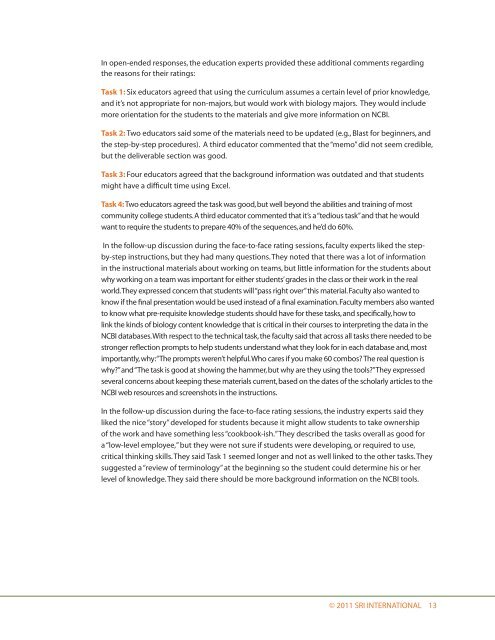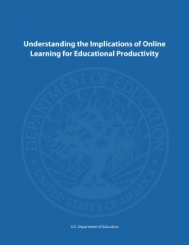Download PDF - SRI International
Download PDF - SRI International
Download PDF - SRI International
Create successful ePaper yourself
Turn your PDF publications into a flip-book with our unique Google optimized e-Paper software.
In open-ended responses, the education experts provided these additional comments regarding<br />
the reasons for their ratings:<br />
Task 1: Six educators agreed that using the curriculum assumes a certain level of prior knowledge,<br />
and it’s not appropriate for non-majors, but would work with biology majors. They would include<br />
more orientation for the students to the materials and give more information on NCBI.<br />
Task 2: Two educators said some of the materials need to be updated (e.g., Blast for beginners, and<br />
the step-by-step procedures). A third educator commented that the “memo” did not seem credible,<br />
but the deliverable section was good.<br />
Task 3: Four educators agreed that the background information was outdated and that students<br />
might have a difficult time using Excel.<br />
Task 4: Two educators agreed the task was good, but well beyond the abilities and training of most<br />
community college students. A third educator commented that it’s a “tedious task” and that he would<br />
want to require the students to prepare 40% of the sequences, and he’d do 60%.<br />
In the follow-up discussion during the face-to-face rating sessions, faculty experts liked the stepby-step<br />
instructions, but they had many questions. They noted that there was a lot of information<br />
in the instructional materials about working on teams, but little information for the students about<br />
why working on a team was important for either students’ grades in the class or their work in the real<br />
world. They expressed concern that students will “pass right over” this material. Faculty also wanted to<br />
know if the final presentation would be used instead of a final examination. Faculty members also wanted<br />
to know what pre-requisite knowledge students should have for these tasks, and specifically, how to<br />
link the kinds of biology content knowledge that is critical in their courses to interpreting the data in the<br />
NCBI databases. With respect to the technical task, the faculty said that across all tasks there needed to be<br />
stronger reflection prompts to help students understand what they look for in each database and, most<br />
importantly, why: “The prompts weren’t helpful. Who cares if you make 60 combos? The real question is<br />
why?” and “The task is good at showing the hammer, but why are they using the tools?” They expressed<br />
several concerns about keeping these materials current, based on the dates of the scholarly articles to the<br />
NCBI web resources and screenshots in the instructions.<br />
In the follow-up discussion during the face-to-face rating sessions, the industry experts said they<br />
liked the nice “story” developed for students because it might allow students to take ownership<br />
of the work and have something less “cookbook-ish.” They described the tasks overall as good for<br />
a “low-level employee,” but they were not sure if students were developing, or required to use,<br />
critical thinking skills. They said Task 1 seemed longer and not as well linked to the other tasks. They<br />
suggested a “review of terminology” at the beginning so the student could determine his or her<br />
level of knowledge. They said there should be more background information on the NCBI tools.<br />
© 2011 <strong>SRI</strong> INTERNATIONAL 13
















